David duChemin's Blog, page 2
December 15, 2017
Making Creative & Technical Choices
This morning I’m going back to fundamentals and answering a question from several months ago that asked, simply, how and why do you choose a particular lens or aperture for a scene. I love this question because it gets to the heart of what it means to be a photographer, or any artist, and that is about making choices.
More of an audio person? You can download or listen to the Mp3 file here:
Click Here to Download the Mp3
After spending most of my last dozen years with photographers, mostly in a teaching capacity, I’ve come to the conclusion that the single hardest thing for photographers is making decisions. If I took all the questions I’ve ever been asked from all the photographers I’ve ever been with, hands down the most common question would hinge around what setting, what lens, what camera, I would use, or how I would do my final edit or pick the images that went into a submission for a magazine or for consideration for a competition, and I think we’re terrified of making decisions. More accurately I think we’re terrified of making our own decisions and being wrong.
So before I answer what should be a really simple question I’m going to dig around a little bit on this issue because more important than you knowing what aperture or lens to use is knowing how to make a decision about these things and having the creative freedom – and courage – to do so.
So. In usual fashion, I’ve got 3 ideas I want to share with you, along with a couple rabbit trails, beginning with the most fundamental: there are no rules. There is no should. When we decide on a lens or aperture or a shutter speed or whatever, we are not discovering the one right setting that we “should” be using. We are making a choice and that choice is based on criteria only you can know. So the most important question you can ask as an artist, a craftsman, or a human being is this: what do you want?
Put another way: what, in this situation, matters most to you? Is it the inclusive look of a wide angle lens? Is it the reach or compression of a longer lens? Is it a sense of motion better communicated at 1/30 of a second? Is it sharpness from foreground to background? Having some sense of what matters to you must be the starting place. Even if you don’t know 100%, and you need to try a few things to discover, in the end, what it is that works best, you need to start somewhere. I’ve found no better place to begin than simply asking myself, “what do I want?” What do I want to say? What do I want the image to look and feel like? This will either help or result in your shrugging your shoulders in which case it doesn’t matter, so pick a lens, get to a decent exposure and then start playing.
The most important thing is that you begin. Not that you deliberate.
Of course knowing what you want to say, or what you want the image to feel like implies that you have a working visual literacy and when you first begin you really don’t. That comes with time. And that, i think is one reason why these questions get asked so often. So I’ve got two things for you. One – when you have the chance, ask the better questions. Don’t ask “hey, what lens did you use for that?” or “what were your settings?” Who cares? That’s not what you really need or want to know; those questions will teach you precisely nothing. Nada. Zip.
The better questions are these: “Why did you choose the lens you used?” or “can you tell me why you used the settings you used?” How did those result in the photograph I’m looking at?
Second, the single best thing you can do to become more visually literate is to study more photographs. And as you study them begin to pull them apart – what lens do you think the photographer used and why? What shutter speed? What aperture? Did these choices make a difference to how the image looks and feels, and why? Ask these questions before you look at the EXIF data, not afterwards. But even when you do look at EXIF data, ask yourself WHY?
Finally, the best way you will learn photography or any craft or skill, is not only better questions but going off, on your own, and doing it. Failing at it. Learning from your mistakes, and trying again. There is no photographer in the world who can tell you which lens to use for one scene or another. There is no such thing as a portrait lens. Every time I see articles titled, This Year’s Best Landscape Lenses, I want to beat myself senseless with my tripod. You can make landscapes with every focal length. You can make portraits with every focal length. There is no best. Someone’s just trying to sell you something. It’s not about the subject but about the aesthetic of the photograph that gives your subject, whatever it is, its best expression. And that, my friends, is up to you and you alone. There’s also no ideal shutter speed for any one particular subject because I have no idea if you want that thing frozen sharp or if you want to pan with it, or even if you want to make it a blurry mess of colour and shape. Only you know this. And if you don’t, try it. Find out what works for you. Because with settings, like lenses, there is no universal “best.”
For a moment, forget the lenses and the settings and all that other technical stuff – stuff that matters and is important because it makes the image look and feel the way it does – forget it all and ask yourself this one question: what do you want? Then, make a choice. No one can do that for you. The choice to go monochrome over colour is a mix of all kinds of reasons for me, reasons that include the subject, the story I want to tell, what I want to with the final images, and somewhere in my gut this indefinable feeling that says “Hell, yes!” when I think about making one series or another in black and white. And you know what? Sometimes I’m wrong. And what I thought was a hell yes is a hell no. Great. Now I know.
This is why vision or intent matters so much. It’s where we begin. And if you don’t know what your vision or intent is at this particular moment, that’s OK too. Use the camera as a tool for exploring that, for playing, for taking creative risks, until you get that Hell Yes feeling inside, that creative excitement that’s saying, let’s see where this goes! That’s why we make the sketch images and try different lenses and settings, to see what gels for us.
I want to let you in on a secret. None of us really has any idea what we’re doing except that we decide to do it. Sometimes we nail it, sometimes we don’t. There’s no manual of “What should you do” that some of us get and some of us don’t. We’re only guessing. Making choices and riding them out until they either get us where we want to be or show us that we’re on the wrong track and then we make a u-turn and try something else. But the moment we get a glimpse of it, a sense of what we want our images to say, to look like, to feel like, then we’ve got the first hints about the next decisions we make.
All this, by the way is how editing works too. You either choose your images based on an expressed purpose – a story or a series or a mood or feeling – whatever, then you find the image or images that do that. For me it’s a hell yes or a hell no. But it starts with knowing what I’m saying yes or no to. And, because we see what we want to see, and sometimes we’re too close to an event when we edit, I almost always do 2 or 3 edits as time goes along, and as I do, often what I’m looking for changes and so too do the choices I make.
It all comes down to choice. Your choice. For some this will be terrifying. I’m not sure what to tell you except that no one ever died from picking f/11 instead of f/2.8 or using a 24mm only to discover an 85 might have been a stronger choice. You’ll learn, but not if you never start making those decisions on your own and evaluating the choices of those decisions based on what you want or need out of your photographs. And for others this will bring you tremendous freedom. Stop looking over your shoulder. No one’s looking. Forget what the magazine article or Facebook post told you to do. Make your choice. See what happens. Then try again. We take this all so damn seriously. Relax. We aren’t curing cancer here.
So. How do I choose a certain aperture or lens or composition or shutter speed or any of the hundred other choices that are mine to make? I ask myself what I want the photograph to look like and then I start making decisions. When the decision feels right I keep going. When it doesn’t feel right, I try something else. And to train my sense of what feels right or doesn’t, I study as many photographs as I can. Early on, there’s also a lot of value in getting qualified critique from people you respect. However you do it, it all comes down to making decisions, owning those choices, and learning from them when they aren’t what I hoped. It comes down to courage and a willingness to risk and learn. Be brave, friends.
Share this Post, Share the Love.
December 11, 2017
Tired of Perfection
This is a little bit all over the place, and it’s raw. But that’s the point of this whole thing. I could do with a little more raw right now.
I’m tired of perfection.
My morning scroll though Instagram just wears me down more every day, with image after image post-processed into plasticity, over-sharpness, and the obliteration of shadows. I’m not even talking about the so-called lifestyle accounts which no longer even pretend to inspire us to wonder, just to baser emotions like envy, or jealousy. I’m talking about the apparent global competition to out-saturate, out-sharpen, and out-technique the rest of us.
In search of this perfection we’re losing the poetic. The grit. The nuance. I see less and less story. Less humanity. I’m all in on beauty, but that’s not even what I’m seeing. It’s all just so damn saccharine. My god, all the shiny, happy – perfect – people. It must be exhausting trying to be all that all the time.
I worry that the desire for perfection is killing the spontaneity and the life in our photographs, never mind the honesty in them.
I worry that we’re becoming so obsessed with the public sharing of our work, and the fear that someone might spot a flaw, that we’re going to work ourselves into such a neurotic lather over sharing our work that making the work (deeper, stronger work) becomes secondary.
It’s already happening. So few people seem willing to just sit on their work and let it mature before flinging it into the world. I feel the pressure the moment I’ve created something to share it. “See,” I feel I need to testify, “I’m still doing good work. I did something today. Don’t forget I’m out here!” And in so doing I share the work before it’s printed, before I have a chance to let it speak to me, suggest an edit, or find a better home for it than the too-temporary gallery walls of social media. Hell, not even temporary, more like ephemeral. A vapour that disappears at the end of a trail of Likes.
How did it happen that Likes have become the highest response to art?
In fact, how did it happen that we have come to refer to what we make – our photographs, our writing, whatever it is – as “content”? As though there’s a bucket out there and our highest calling is to keep the damn thing filled with…anything. Just keep it filled. Content is king, after all.
F*ck the king.
No one longs for “content.” We want connection. We want hope. We want wonder. We want to look at something and feel something deeper than whatever it is that moves my finger to click the Like button.
I don’t want to “like” your art. I want to be moved by it. I want it to make me think. To make me uncomfortable. I want it to raise questions. Or stir me to wonder. And I want my own art to do the same. It’s a lofty goal. Some might say a pretentious goal. Whatever. The heart wants what the heart wants and I want more.
I started down the road of this craft because I encountered photographs as a teenager that grabbed me, that made me tear them from magazines and put them on my wall. I revered those images. I lived with them and thought about them for months. I knew the names of the men and women that made these incredible images and I wondered what it would take to be like them. It never occurred to me to ask what lens they used because I suspected deep down that whatever it took to makes those images was so much more a part of the artists themselves than the particular gear. It had something to do with determination, grit, a stubborn, patient, refusal to do anything but whatever it took to make the photograph. I wonder if they got to their best work because they were busy doing it, not posting their initial successes on Instagram instead of digging deeper. Instead of taking the long slow road to mastering a craft.
I read something somewhere recently, or maybe I heard it in a video or, God help me, a tweet. It was suggested that we are not teaching people to revere our work. That one line grabbed something in my heart and mind and hasn’t let go. Of course we aren’t. We’re putting it so quickly into the world and it’s forgotten almost as fast. We’re treating it as though it’s disposable. Shoot. Share. Move on. And in that context no wonder the movement is toward the perfect. The shiny. The eye-candy. There is so little room on those particular walls for depth. Vulnerability. Imperfection. Connected bodies of work. Narrative. Symbolism.
This isn’t a rant against social media. It’s a plea that we transcend social media and do something more with our work. That we encourage people to revere it by revering it, and honouring it, ourselves. It’s a plea to print our work, and live with it, and be slow to sign it. It’s a plea to put it in books or in places we can thoughtfully react to it, not merely consume it. It’s a plea that – for the love of Ernst Haas and all the saints, we think of our work as more than just “content.”
Most of all, as so much of what I write is, this is just a reminder to myself that in the flood of all these perfect images and lifestyle accounts, I am not required to be perfect. Flawless. I’m reminding myself and anyone that’ll listen to me that the flaws, and the cracks – thank you, Leonard Cohen – are where the light gets in. You are not required to be perfect, just present. It’s important we curate our work, but it’s probably best that we feel no need to curate ourselves, to be anything more than we are.
-David.
Share this Post, Share the Love.
December 4, 2017
Shoot Like A Pro?
If I hear one more person or read one more camera ad that tells me to SHOOT LIKE A PRO! I swear to god I’ll start drinking gin from the cat bowl and Fluffy can go drink out of the toilet. What is this obsession with being a so-called pro as if it’s the highest calling of the photographer and everything they touch turns to gold? Being a professional photographer is not a badge of honour, it’s not easy, and for some of you it could be the worst thing you do to the craft you love.
More of an audio person? You can download or listen to the Mp3 file here:
Click Here to Download MP3
Listen, before we go any further, I love being a “professional photographer.” I love making a living from my craft and my creativity, so you won’t find me talking down about this as a vocation. But once in a while someone asks me about this in terms that lead me to believe they’ve been told by someone that until they’re making their living from photography they aren’t a real photographer. Can you imagine Olympic athletes being told they aren’t “real” athletes because they aren’t professionals?
The word professional means a lot of things to a lot of people. For the sake of this conversation it means you make much of, or all of, your money, from photography. It doesn’t necessarily mean those photographs are good. It doesn’t mean you’ve been doing this for any amount of time, either, which is probably one of the reasons being a professional doesn’t necessarily mean your work is any good. In this conversation it means you make money. Or you flounder desperately trying to do so. It’s not easy. So because I was asked point blank last month: “should I become a professional photographer?” – let me give you some thoughts and you can make up your own mind.
First, if your Mom told you, “hey, you know, these pictures aren’t bad, you should become a professional” then your mom and I need to talk. Being a professional photographer – no, wait: being a successful professional photographer does not mean you take pictures real good. It means you are an entrepreneur.
This is a business. And to do it well you need to master not one craft, but two. It is assumed you will master your photography. Some don’t and they fail. But some are incredible photographers, with more vision and craft in them than I have in my little finger, and they can fail too. Because no business in the world succeeds based only on how good their product is. You have to become an entrepreneur. You need to be as good at marketing and sales and cramming 26 hours worth of work into a 24 hour day as you are at making pictures. You have to be motivated to get out of bed in the morning and get to work. Ask any wedding photographer how much work they put into a wedding and how much of it is shooting vs client meetings, networking, post-production, file delivery, invoicing, and follow up.
If you want to be a photographer and have all the freedom in the world to shoot what you want, when you want, how you want, then keep your day job. Because “going pro” is a commitment to starting and running a business.
8 out of 10 small businesses fail. And if that business is yours it probably won’t be because you weren’t a better photographer but because you didn’t understand that in business the craft of being an entrepreneur comes first. People always talk about “doing what you love” for a living. Hell, I talk about it all the time. But it applies to me not because I love photography, which I do, but because I love the business side of things as much as the photography. I’ve been making a living as a creative professional all my adult life. If you don’t love being an entrepreneur and working 12 hours a day so you don’t have to work 8 hours a day for someone else, then being a professional photographer probably won’t, for you, be doing what you love. In fact it will steal your joy.
One of the misconceptions about doing this for a living is that you get to spend all your money on toys and if you want to bathe in a bathtub filed with Leica lenses, you can do that. It’s a write off! Bullsh*t. This idea that something is a write off and therefore costs nothing is so wrong-headed it blows my mind, and it’s why so many businesses fail. Businesses exist to make profit and the more money you spend on gear and the stuff you lust after as a photographer, the less profit you have. End of story. A write-off just means you spend less tax on the money you made that eventually paid for that new toy. That’s it.
If you want to spend your spare cash on gear, don’t become a working photographer, because working photographers spend their money on some really boring shit. Aside from travel and the rare piece of new gear, you know what I spend my money on? Things like online services: Dropbox, Shopify, MailChimp, Freshbooks. Web hosting. Insurance. Printer ink! Boring, boring, boring. I spend it on my manager, my accountant, my editor, and designers that do my website stuff. All vital things. I need those people, and those services. But they aren’t romantic or exciting expenditures. And sure, once in a while I buy a new toy and I can feel my accountant roll his eyes because in business if something you buy doesn’t make money it’s a liability, not just a toy you can play with while feeling no guilt.
Being a professional is a massive trade-off, and for most people it’s not the trade-off they imagined. But let’s say you aren’t deterred by this little pep talk. Let’s say for a moment that you just can’t not do this and you really, really, want to be – or continue to be – a professional photographer. What now?
First – get comfortable with splitting your personality, and setting your photographer personality aside for at least half the time so your entrepreneur personality can focus on his or her craft without getting distracted by Instagram or the B&H catalog for a while. The entrepreneur side of you doesn’t – must not – give a shit about photography, especially shiny new gear. His or her only preoccupation is making money so the other side of you can make photographs and serve clients. She is not swayed by your justifications for a new lens or camera bag because she knows you need to make tax installments or put money into savings or pay your insurance.
You have to, have to, learn your craft as an entrepreneur. The success of your business depends on this and if you want to reward yourself with a new camera at the end of the year because you’re doing well and your finances are in the black and you’ve got money saved for taxes and your family is fed, then it all depends on how well you study – and execute- your craft as an entrepreneur.
Second – The raw materials of the photographer are light and time. How well we master them determines how well we make photographs. The raw materials of a business person are time and money and how you master those two things determines the success of your business. You must get comfortable talking about money. You have to be able to look a client in the eye and give them your price without flinching, not because you’re a bad-ass but because you know how much value you bring, you know how well you can solve their problem, and you know – to the dollar – how much it will cost you, personally, if you under-charge. This is part of learning the craft as an entrepreneur: you’ve got to learn to manage your time, get shit done, and have some kind of financial literacy. You can’t wing it. When you open shop you become not only the chief photographer but the CEO and the VP of Finance. Would you hire a VP of Finance that can’t stop going into debt, spending frivolously, or won’t put enough money away to save for taxes, insurance, professional fees, contingencies, and employee salaries? I don’t think so.
Third – Now that I’ve got you wondering if it’s not time to start drinking gin from a cat bowl of your own: you don’t have to do this alone. You learned how to be a photographer one step at a time. You learned the craft. You can learn business craft too. If you don’t know Thing One about finances, there are bookkeepers and accountants who do, and you can learn from them. If you don’t know about marketing, there are books and people out there who can help you learn. Just be sure this is what you want to do.
We all do this – photography – because we love it. Some people get into the professional side of things thinking it’ll give them more time and money to do what they love and it just sabotages it. And for some – like me and countless others – it’s a good fit for our personalities and we love the added challenges. But you don’t have to do this to be a “real” photographer, and shame on anyone that ever made you feel that way.
If you were listening you’ll notice I never once used the word “amateur” to describe the opposite of “professional” That’s a false dichotomy. Or it can be. Amateur means lover – one who makes photographs for the love of it. That is what we should aspire to be. That is the badge of honour, the high place from which our best work is made. If you can be a professional without losing that, great. But don’t strive to do anything that will steal the joy you find in making photographs. Don’t trade the passion for the business cards. It’s not worth it.
Alright, that’s your sermon for the week. If this kind of conversation is important to you there are two resources I want to recommend. The first is my book VisionMongers, Making A Life and a Living in Photography and you can find it on Amazon here. Leave a comment below and I’ll chose one of you to send a signed copy of VisionMongers with my thanks for reading. The second is a quick PDF resource I created, totally free, called You Can’t Fix It Later in Photoshop, How to Avoid the 3 Most Common Mistakes in Business and Thrive – when you download that PDF I will begin sending you my VisionMongers Dispatch, which is a monthly conversation about honing your craft as an entrepreneur, and I’d love to have you be a part of that if it’ll help you do what you love and succeed at it, both in photography and in business.
Share this Post, Share the Love.
November 27, 2017
Postcards from Lesotho
After 2 weeks in the highlands of Lesotho I’m back in Johannesburg for a couple days to wash the dust off and get the bumps massaged out before beginning the long journey home. The highlight this morning was waking up in a bed that was not my sleeping bag, and getting a cup of coffee that was not powdered Nescafe. But I’d do it all again (and will!) for the experience I just had.
The last two weeks in Lesotho (look at a map of South Africa. See the donut hole in the south-east? That’s the Kingdom of Lesotho) were among the purest travel experiences I’ve ever had. I don’t know of another way to put it. I traveled with two friends, one functioning as my producer, the other as my fixer. The latter spent 3 years living in Lesotho and knew the language and the communities in which we traveled, making an otherwise impenetrable country much easier. For fourteen days we hiked through villages, took horses into valleys, and drove the Land Rover through high mountain passes, all to connect with, and photograph, the balisana (pronounced badisana), the shepherds of the highlands of the mountain kingdom. The word “epic” got used a lot, never in exaggeration. We saw no tourists, and no NGO workers, both normally so ubiquitous in Africa.
The shepherds are a fascinating culture all their own and this is, I hope, the start of a long term project to photograph them. We spent time with them in all weather – arriving in Lesotho to a foot of snow and a blizzard, and leaving the country in heat and sunshine – and photographed them doing everything from watching their flocks to shearing them and going to church on Sunday to dance their hearts out. I can’t wait to go back.
Here are a few of the photographs from the trip. If you’re on my mailing list and getting The Contact Sheet, you’ll get a more robust PDF monograph that represents a better first peak at this work. I’ll send that out once I’m home and have a moment to put it together.
Not on my mailing list? Get The Contact Sheet by going to MyContactSheet.com and downloading my short eBook with the un-necessarily long title: 20 Ways to Stop F*cking Around With Your Camera and Make Better Photographs Without Buying More Gear. That will automatically give you a subscription to The Contact Sheet and get you the first real look at all my new work as it comes out, as well as articles I don’t post elsewhere about the craft of photography. Of course it will also get you a nice-looking updated version of my original eBooks, Ten and Ten More, with my thanks for letting be part of your creative life.
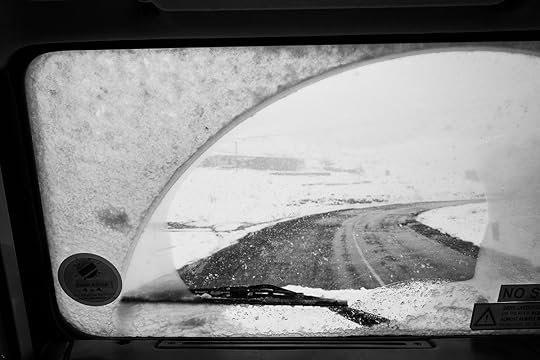
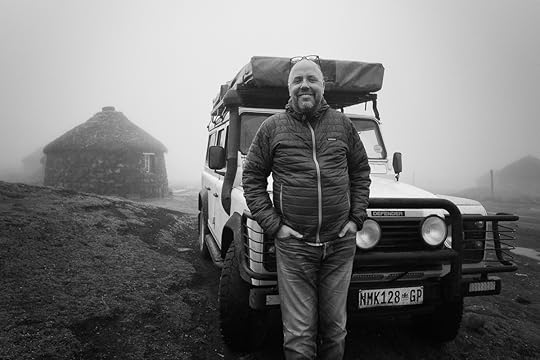
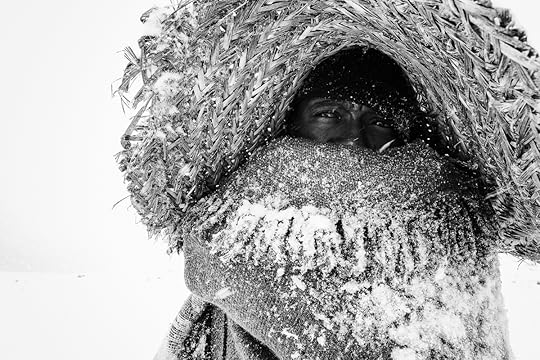


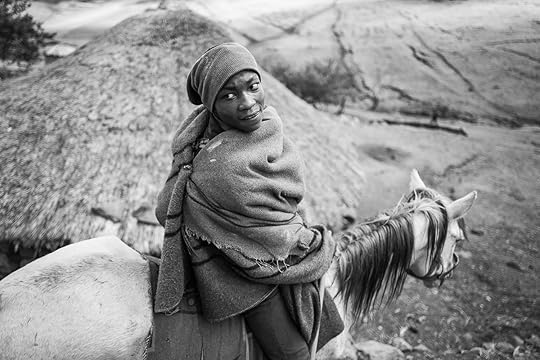
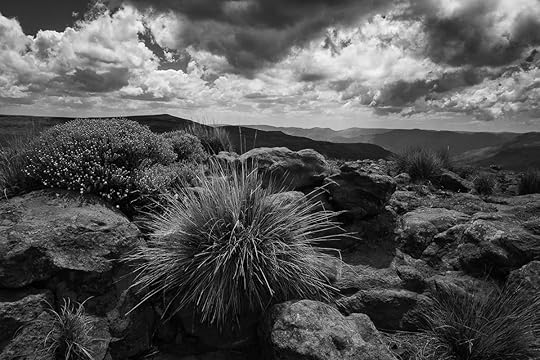
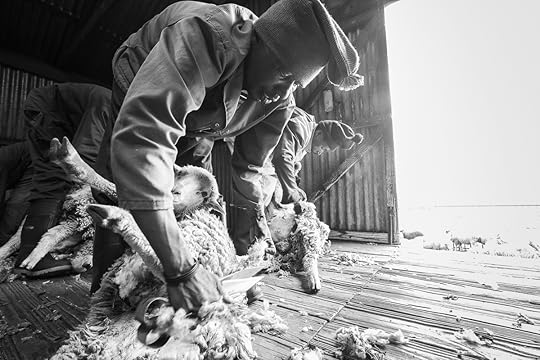
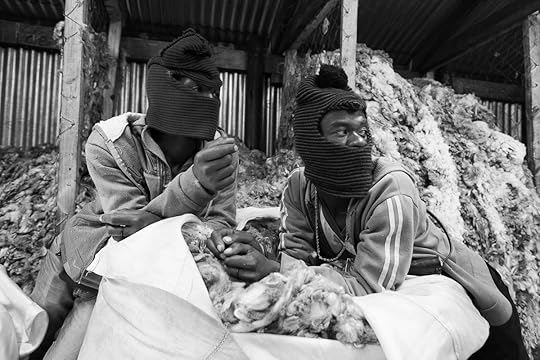

Huge thanks to Andre, from Focal Change, and our very capable friend and fixer, Eric Noseworthy, for this incredible adventure. This assignment was meant to happen 2 years ago but got postponed when I threw my back out 2 days before I was meant to get on a plane. Thanks for your faith in me, and for your patience!
Share this Post, Share the Love
November 15, 2017
How To Get Sh*t Done
Have you ever felt like you’re insanely busy but not actually accomplishing anything? Like you’re frantically doing stuff but never getting stuff done? Being creative, no matter what the discipline or genre means making things, it means creating, and to do that – whether it’s one photograph or a significant body of work, never mind all the things we need to do to run our businesses and live our lives, we’ve got to get shit done. Let’s talk about it.
If you’d rather watch this on YouTube, it’s Episode 74 of Vision Is Better. More of an audio person? You can download or listen to the Mp3 file here:
Click here to download the Mp3 Audio File of this VIB Episode.
In the last post I discussed the danger of burning out and my final observation was that it’s entirely possible to burn out while getting nothing done at, while being busy but not productive. The more I thought about that more true it seems. In fact the more it seems like that’s the fastest way to burn out. And I talked about the power of saying no, and of triage thinking, and I think those things are not only the secret to not burning out, they’re one of the secrets of productivity.
Getting shit done – being productive, not busy – is a big subject. And if you’re going to get shit done you need to get off the YouTube shows and FB and the blogs, so I’m limiting this to my top 5 ideas for being more productive.
Number One
Know what you want. If you’re going to “get shit done” you need to know what shit needs doing. I keep an Evernote file with priorities for the year – the big picture stuff. The stuff you really need to do – the big bodies of work, the projects, the deep work. By the way I get this idea of Deep Work from Cal Newport’s book of the same name – Deep Work. Highly Recommended. Take some time and ask yourself what you want to do in the next year or two. The big stuff. The stuff you want to be known for. The stuff you want to look back on one day and be proud you accomplished. Once you’ve done that, start planning.
Number Two
I told you I keep an Evernote file with priorities for the year but I generally plan the big stuff 2 years out. Why? You’ve got to put the big rocks in first. Have you heard that illustration before? If you’ve got a jar and you need to fill it with both tiny pebbles and big rocks, and you start by putting in the pebbles first, you won’t have enough room to get all the big rocks in. if you put the big rocks in first, then the pebbles fit into the remaining space. It’s about priorities and being willing to put big stuff onto the calendar first, and letting the small stuff fill in the gaps, knowing it can’t work the other way around. Big rocks first. And in order to do that you have to know what those big rocks are for you. What are the most significant things you need to do this year? How much time will they take? Put them on the calendar now. If I’m doing a big project in December 2018 I put it on the calendar and work backwards. If I want it done by December, and I need a month to do the project then I need to put a month of project time aside in November. Put a big red line through it. And if I need a month of planning time before that, I cross out October too. Big rocks go in first. Always.
Number Three
Get rid of some of the smaller rocks. I know I can’t fit everything in so I do what I can to minimize the small rocks I need to get into the jar. This is what I was talking about in the last episode. Saying no. If it doesn’t serve my bigger vision, put food on the table, or in some way make my life (and the lives of those closest to me) better, then I do what I can to exclude it from my life. Just say no. And if it’s small stuff and you can’t exclude it then BATCH IT. Stop checking Facebook once every ten minutes, instead check it once in the morning and once in the afternoon. Same with email. You’re clearing chunks of time so you can put larger rocks in. This concept is so important to me. I can’t write anything in 10 minute chunks. But put a few of those together, taking out all the little distractions, and give me 1 to 3 hours and I can get some serious work done. Clear out the little rocks by batching them together. Jealously protect your large blocks of time.
Number Four
Stop multitasking. Don’t do it. We all think we can do it, but study after study shows we can’t. We’re terrible at it. If you want to not only get shit done but you want to do it well, you’ve got to focus. I don’t think I need to even explain this. You’ve just got to focus. This goes hand in hand with number three because you need blocks of time to really focus but you’ve got to be single-minded about stuff.
Number Five
On a smaller scale my productivity has gone way up as I’ve transitioned from keeping a TO DO list to just putting stuff – even the smaller tasks – straight on the calendar. Putting it on a list says “do this at some point” putting it on my calendar says “do it now.” I still keep the list because that’s where things go before I put them on the calendar. But if I sit down on Sunday and think about what I need to do in the coming week, the stuff comes off the list and goes onto the calendar. I schedule it. And if it’s too big or too vague to schedule – like “write the next book” would be too big – then I break it down into things I can schedule. if it can’t be scheduled then it’s too big, it’s not actionable, and I break into smaller pieces. So if “write the next book” is too big, then “outline the next book” goes in on Monday, and smaller steps follow. Next week it might be “Write Chapter One.”
Lastly, here’s a bonus: don’t wait until you want to do it. Don’t wait until it seems like fun or you’re in the mood. I get shit done because my rational brain puts actionable bite-size tasks on the calendar in service of getting the big rocks done. If I didn’t do this I’d be constantly looking at a To-Do list thinking, which of these overwhelming tasks do I want to do today? And the answer, as it always is, would be, none of the above!
We all work differently so none of these might apply to you. In that case figure out what does work for you, but this is the best framework I’ve found for myself and it’s worked well over the past 10 years. I’ve written 9 significant books, 20 ebooks, and a handful of other resources while running a business, traveling the world, and leading workshops. I’ve learned to make the most of my time, to do work on planes when I know I’ve got 4 relatively uninterrupted hours or on layovers when I can either groan about being bored for 8 hours or I can get 2 chapters of a book written. I’m not saying it to brag, in fact there are a lot of things I’ve left undone. But if you want to get shit done, however you do it, you’re going to have to make it happen, and that means knowing what you want, getting the big rocks onto the calendar first, getting rid of as many of the smaller rocks as you can, and bringing greater focus and actionability to your creative life.
Got questions, thoughts, or ideas, about this? Leave them in the comments. I’m in Lesotho right now, but I’ll reply the moment I’m back. Now get out of here and go get shit done.
Share this Post, Share the Love.
November 7, 2017
Everyone’s A Photographer?
I posted this to FaceBook one year ago and now seems as good a time as ever to post this here.
I was speaking last year at an event with a panel of photographers. There was a Q&A afterwards and someone asked me what I thought about this idea that “everyone is a photographer.” I told her I agreed. Everyone is a photographer.
My answer made her angry. Fear will do that to you.
You can’t have a conversation with so-called professionals these days, or spend much time on social media these days without hearing someone decry the fact that now that everyone has a camera everyone “thinks they’re a photographer.” Much agreement follows. Also grumbling. Then someone uses the word “faux-tographer” and someone else uses the word “Mom-tographer” with a sneer, and don’t even get me started on all these kids these days with their iPhones. Who do they think they are? Get off my lawn and get a real camera, kid!
When did we become so small? So fearful? When did we crank our hearts down to f/22, lest the light get in? When did we forget the moment we picked up our first cameras and felt the wonder of it? When did we forget the moment we nervously took our first paying gig, wondering what the hell we were doing and whether we’d just bitten off more than we could chew?
We have made too much of the word “photographer.” We have gilded it with gold. We have idolized it. We have stopped looking through the lens at the incredible world around us and the people that enrich our lives, and we’ve started looking in the mirror instead, polishing the brass badge that says “Photographer.” When did what we call ourselves become so f*cking important? We spend so much time looking at ourselves that we don’t have time to look at the photographs anymore. We compete with others, driven by jealously and fear, when we should be celebrating their work and letting it open our eyes.
When, in the desperate need to protect this new golden calf, did we decide we were the adjudicators, the ones who decide who is and who is not a photographer?
We can do better. We need to do better. Right now we risk getting stranded on the moral high ground, and I’m pretty sure the photographs coming out of frightened hearts aren’t the strongest ones to be made.
Let them be photographers. Let them make photographs with all their hearts, so you can go back to doing the same. I know, some of them might be terrible. Mine were terrible for years. Saying I’m a photographer doesn’t mean I’m a good photographer. And it doesn’t make you any less of one. Let them have this if they want it so badly. Remember when you did?
And if you’re genuinely scared by a landscape in which everyone is a photographer, remember that nothing you say or do will change that. The only thing that will grow your business (because that’s what most of this comes down to: money. And the fear of making less of it.) is you being a better photographer, a better storyteller, a better marketer, a better networker. But know this: no one wants to do business with bitter people whose gaze is more inward that outward, whose most creative work is the dubiously clever act of coming up with new words with which to trivialize and ridicule people who love photography as much as you once did.
Remember when photography opened our eyes and heart and mind instead of closing them?
Remember when this was fun?
Let’s go back to that.
_____________________
Feel free to share this. The world needs more kindness and love. It needs people that can see clearly more than ever. Photography can do that. The more the better.
Share this Post, Share the Love.
Photo credit: Jason Bradley
November 3, 2017
For The VisionMongers
When I was what I recall to be about 10 years old we made these little googly-eyed creatures out of bark and thistles and stuff in art class. Looking back I have no idea what possessed me to then go home and make hundreds of them and take them door-to-door in my neighborhood to share the love and make a few bucks. It was December and I called them, ahem, Christmas Critters. It might even, God help me, have been Kristmas Kritters. I was ten. Don’t judge me. You can roll your eyes now but I cleaned up and filled my jar with cold hard cash. An entrepreneur was born.
I’ve been a creative entrepreneur all my adult life and I’ve run the gamut from total failure and bankruptcy to running a business that is, by any metrics, more successful than I ever imagined. I’m good at this stuff. Rather, I have learned to be. Entrepreneurialism is a craft, and like photography it can be learned. Honed. So many photographers go into business for themselves, wooed by the idea of doing what we love for a living, but they fail because they work so hard on the one craft but completely neglect the other. If photographers are going to succeed at business they need to learn to think like entrepreneurs and learn that craft well.
8 years ago I wrote a book called VisionMongers, Making a Life and a Living in Photography (find it here on Amazon). It became a best-seller in the photography world which tells me it was scratching an itch that had been left, well, unscratched. But then I got busy and while the book continues to find readers all over the world, I never really picked up the thread and ran with it, mostly, I think, because I just got busy doing my own gig and serving clients. I’m picking up that thread again.
There’s almost nothing I love more than being an entrepreneur. It’s a different way of being creative and I’m good at it (thanks in large part to my past failures and willingness to learn from them.) But it’s hard, especially if you want to grow and thrive, and not merely survive. So I’m doing two new things for the VisionMongers out there, and they’re connected.
The first is a short new PDF guide called You Can’t Fix It Later In Photoshop, How to Avoid the 3 Most Common Business Mistakes in Photography and Thrive. Not my shortest title ever. The second is a new resource called The VisionMongers Dispatch, emailed to you monthly with articles, resources, and new insights into learning your craft as an entrepreneur in the photography world. The two are connected – just download the one and you’ll begin getting the other, and if you find it’s not for you, you can always unsubscribe.
Photography has given me an incredible life and doing so professionally continues to be a wonderful adventure. I want to help others – to help you – live the same kind of life. To share the lessons I’ve learned. They were hard-earned and expensive and there’s no reason you should have to learn them as painfully as I did. If you want to hone your craft as an entrepreneur as intentionally as you hone your photography, I’d love to be part of that. I hope these new resources can help you.
Share this Post, Share the Love.
October 31, 2017
The One About Creative Burnout
I’m tired. Not like the “I need a nap” kind of tired, but the kind of tired that goes into your soul and slows your thinking and makes you dread the things you were so excited to put on the calendar only a few months ago. The kind of tired that feels like the first signs of burning out. And I know I’m not alone. The risk of burn-out is common to creative people because we tend to live through cycles of low productivity and incubation followed by massive productivity. We work when the work comes and we crank it up to 11 when the inspiration strikes and the flow is happening. We make hay, as they say, when the sun shines, and some times the sun shines for more hours in a day than we have energy for.
So I asked on Instagram for some ideas about my next couple episodes, and Lola asked me how I keep from burning out, it seemed like a good time to ask myself the same question. How do I keep from burning out? God knows I’ve been close enough. I’m there right now. But I’ve been making a living exclusively from my creativity – with the exception of a brief stint at Kentucky Fried Chicken (let us never speak of this again!) – all my adult life. And I know that burnout or creative exhaustion creeps up on you. And when it does it flattens you.
Here’s how I look at burn-out. We all only have so much fuel, creatively. And that fuel burns at different rates depending on a lot of things: how tightly we schedule ourselves, how much we love the work we’re doing, both in terms of the process and what we’re actually creating, and how much fuel we’ve actually got on hand. The fuel itself is a personal blend of all kinds of things including how many ideas we’ve got going in the background, where we’re at emotionally, and our physical well-being. It’s probably other things too; we’re all different. But here’s what I know: if I don’t control the burn, I end up with this bright hot flame and then phhhht! Nothing. And if that happens it’s much harder to get the fire going.
So how do I control the burn? How do I keep things burning at a desired level without flaming out? Well, I don’t always. Right now’s a good example of that. I got home from my last set of workshops that came at the end of an insane several months of travel and new projects that took a ton of my time but even more of my emotional energy and I’m now looking at my fuel reserves and they’re dangerously low. So the first thing I do is protect myself. I start saying no to everything that is not a high priority or will not help re-fuel me. That’s not easy. But you have to say no. That’s the way you avoid burn out. I should have said No to some things sooner but you don’t always know. Sometimes you do your best, things are going well and you plan into the future and let “future you” deal with it, only to get there and find out, “Shit. I’m future me! And I just don’t have the resources I thought I would.”
Saying no, learning to get good at triage thinking, is really important. And if you don’t like saying No, think of it as saying Yes to more important things. You have to start saying NO. That’s the simplest answer to the question. But most of us need to back it up a bit in order to know what we need to say No to and you can only answer that by knowing what you want out of life and what’s truly important to you. And yes, there’s a real balancing act in there and most of us suck at balance but you need to be able to say, “This is important and in order to say yes to this I need to say no to other things.”
I get a lot of things done. I’m extremely productive. But it only happens by being a little ruthless with not doing other things. And once in a while I take on too much and I need to dial it back. Simple as that. If you don’t dial it back you burn out.
But you also need to keep the fuel coming in. It’s really important to me to keep new ideas coming in, so I’ve always got 2 or 3 books on the go (reading, not writing). I read for about an hour a day because without reading something new, without wrestling with new ideas, either about creativity or art or being an entrepreneur, I have nothing to work with. Those are my raw materials and if they run out, it’s the same as burning out. I just run out of fuel. My most productive times are long slow burns with one or maybe two important things going on on the front burner, one or two important things on the back burner on a simmer, and a constant supply of new ideas – mostly from books and from conversations with friends.
Here are a few other things I think are important, at least to me.
Burn out happens way faster for me when I compare myself with others. So if I’m working hard on my own projects I consume very little social media. When I’m working on new stuff it’s all about the stuff and not about other people. I don’t want to be influenced, the time for influence was before I was doing the work. And if I’m getting distracted by Facebook or Instagram or whatever, I’m not doing my best work. I’m not doing deep work.
I also get way closer to burn out when I don’t take time to eat well or to get some exercise. The brain is a physical thing and it works best when it’s healthy and has lots of water and oxygen and I’m terrible at this stuff but I can tell you if I’m struggling the best thing I can do is go for a walk. Go outside. Breathe some air. Move my body. Or take some time off, turn off the phone, open a bottle of wine and do something else completely. The answer is almost never just to stop what I’m doing and go on vacation. Doing nothing at all stresses me out. This isn’t workaholism, I just love what I do and my brain needs to chew on things or it goes mushy.
Ok, so what do you do if you have already burned out? Get more fuel and light the fire. Creativity only happens when we get back to work. So look, if you’re a photographer and you burned out, and you took some time off, and you know it’s time to get back to work and you have no idea where to start, it’s not where you start that matters. It’s when. Start anywhere. But start now. if you wait for inspiration to strike you’ll wait a long, long time. Inspiration strikes when we start working. The magic is in picking up the camera and starting.
It’s the same with writing. Most of the time when I’m writing I hit a wall. I don’t think I can write another word. So I take some time to refuel, and I still have no frigging idea what I’ll write but I start. And I start ugly. And the first stuff is garbage, but as i write I find a groove and I start. That’s how it works. And it’s the same with the camera or the paint brush or whatever your particular tool is. You start working. You start ugly, and slowly the muse shows up and things begin to flow.
And in the in-between time: do something different. Mix it up. Try something you’ve never done before. If you normally zig then do some serious zagging for a bit. Don’t take yourself too seriously. Go have a bottle of wine, take a week to pick up the guitar again or learn to draw. Give your brain a break. Ultimately I think burn out is about pacing, not about how much we do. Some of my best times have been insanely productive and I haven’t been close to creative exhaustion or burn out. In fact I think its entirely possible to get totally burned out without accomplishing much at all, like a 4-year old that just runs around the living room on one of those red-line sugar highs and then collapses, we’re busy, busy, busy just spinning our wheels so next week I’m going to talk about getting more done, being more productive, and these two ideas can balance each other out.
This is a transcript from Vision Is Better, Episode 73. If you’d rather listen to it as an Mp3 file you can download that here, and if you’d rather watch the episode on YouTube, you can so that here.
Share this Post, Share the Love.
October 7, 2017
Postcards from Venice
The train from Venice pulled out only minutes ago, heading south to Florence and away from the city that, after 8 years, I’m only now beginning to really discover, though I’ve loved her – quirky, busy, impossibly tangled with tourists, as well as beautiful, romantic, and bathed in light – from the start. Florence will be a quick one, 4 days between workshops to catch my breath, and catch up with email, in between visits to the Uffizi gallery and some favourite wine bars. And then it’s on to Rome for one last week of MentorSeries Workshops in Italy. The next ones will probably not be until 2019 or 2020.
The last two weeks in Venice were a creative surprise. I expected to spend a little time making moody black and white photographs. Instead it was all colour all the time, mostly reflections, silhouettes, and shadows. The muse wants what the muse wants, I guess. Maybe next time. And yet, I’m thrilled with the results. It was nice to see Venice a little differently.
Here are a few of the images from the last two weeks in this fabulous city. As always, if you’ve got questions about the technical or the creative steps that got me here, feel free to ask! I’ll drop you a line the next chance I get.
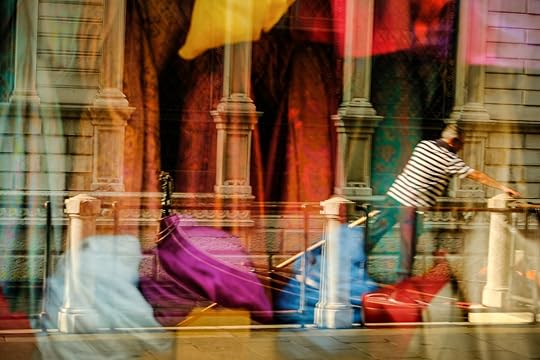

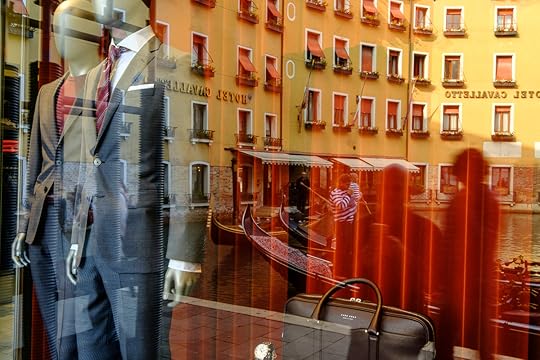

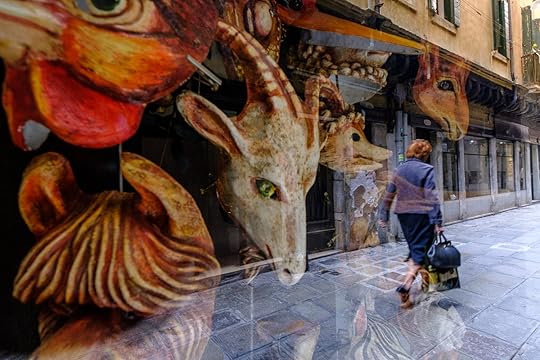
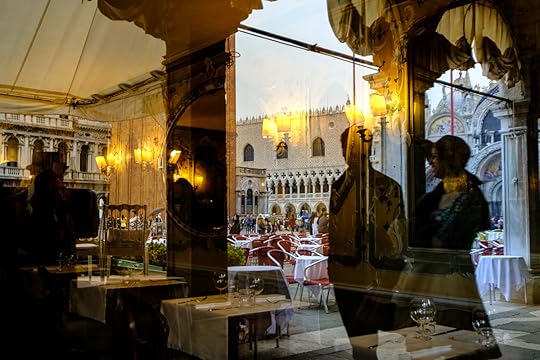

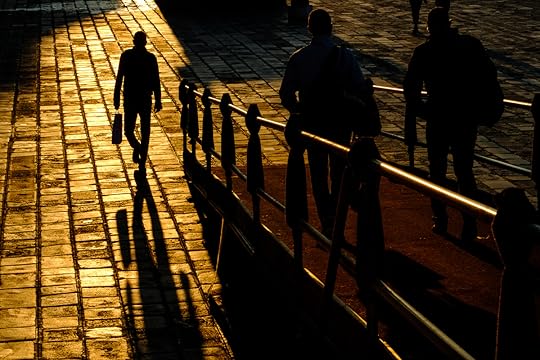

Share this Post, Share the Love.
October 3, 2017
How to Deal with Creative Boredom
I get about a dozen emails or comments on social media every month asking me what to do when you wake up one day and you realize you’re bored and you feel like your photographs are boring and because the only only thing worse than making boring photographs is being bored yourself, and because I think there’s a connection, I want to talk about it.
I have this sneaking feeling that when we create while bored, assuming the act of creating doesn’t pull us out of that boredom, there’s a good chance that what we make will be, well, boring. I also think boredom is just one of those obstacles in the life of any creative person and what you do with it will determine how quickly you get back to the work of making things you love, that stir you – and others – and take you to new and interesting places in your creative life.
So what is boredom and how do we get past it to the place where we’re making exciting images again and finding greater satisfaction in our work? First, I’m not a psychologist so on some level I’m just kind of making this up, but I’m doing so after 24 years of making my living from my creativity and dealing way too often with boredom. The best definition I ever heard of boredom is that it’s “the lack of a lack.”
We’re not good with nothing to push us, nothing to discover, to figure out, without challenge. I talk often about creativity needing something to push against, like a muscle. Our attention is like that too – it’s needs to be looking for something it doesn’t already have or learning something it doesn’t know. It needs something to gnaw on. Boredom is like the hunger of our minds, of our attention. It’s our brain screaming out for something to chew on. I’m pretty sure you won’t find that in a text book, but it’s the best way I can describe how it works in my own life and how it threatens my creativity and productivity.
So what do I do when I’m bored?
Same thing I do when I’m hungry. I get something to eat. I feed my brain the thing it craves: challenge. I give it something it’s no good at, something hard, something unfamiliar. I give it a hole to fill. And the more bored I am, the bigger the challenge I need. What does that look like? It depends on the context in which I’m feeling that boredom, but if it’s with my camera in hand I do something different, go somewhere different. I give myself a problem to figure out. Something hard. I learn a new technique or photograph something I’ve never photographed before.
A couple years ago I was bored in Venice and combined that with my frustration about selfie sticks and I went out just to clear the cobwebs and I pushed myself to shoot pure candids, with a longer lens. Some people feel really uncomfortable getting close to people with their camera. I’m the opposite. I feel incredibly uncomfortable with a long lens. I feel like a voyeur. A sniper. So I went out determined to photograph people with selfie sticks and it was a challenge but it sparked something because it was a new subject and it was a challenge, if not technically then emotionally and creatively. And I ended up staying out much longer than I expected and creating work I loved and the boredom disappeared. It also lead to a whole new personal project that I’m still working on and I’m loving the challenge.
Here are a few of the images from Venice and the subsequent longer-term project:

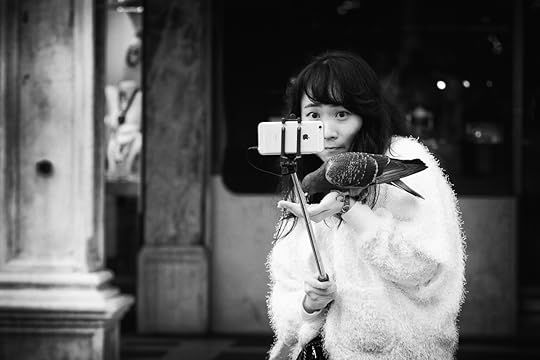
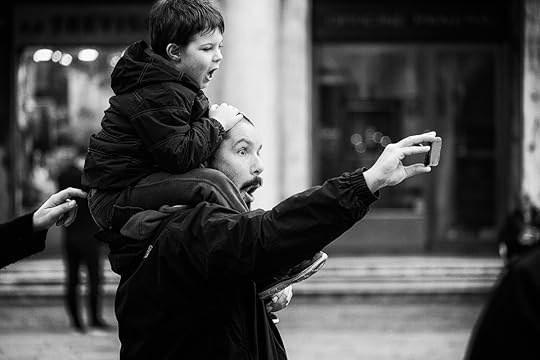
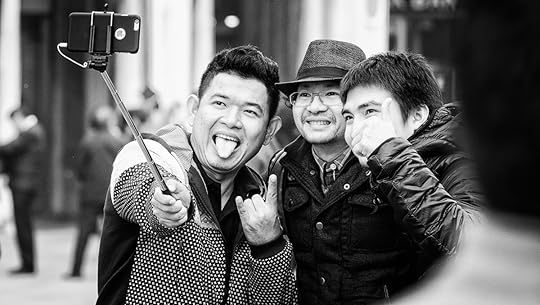
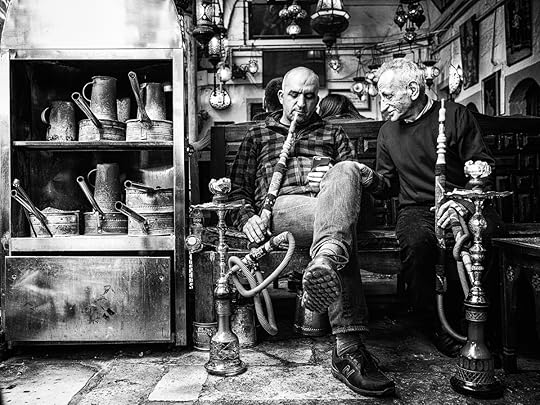
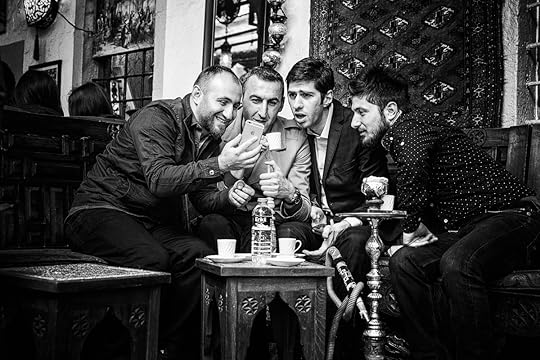
I don’t know a lot of people who just naturally choose to maintain the creative discomfort of constant challenge. It feels good to just kind of coast along. But without challenge we will never get to the state of creative productivity and satisfaction that we know as “flow.” Flow is the state of mind we hit when the creative challenge we undertake is just a little out of reach of our skill or comfort level. So we have something to reach for, we’re just pushing beyond our limits, but never so much that we feel like it’s impossible and we give up. Flow is that state of being where we get so immersed in something that time just passes unnoticed. It’s also the state of being in which we make our best work, and I’d be willing to say it’s opposite is boredom. But the pre-requisite is challenge. No challenge, no flow.
So if you’re stuck, and you’re bored and you look at the work you’re making and you feel nothing but ambivalence toward it, perhaps it’s time to shake things up, to give yourself a new challenge, to create some constraints for yourself. Learn to do something new or use a new piece of gear. Pick a new compositional element and learn to use it well. When’s the last time you made a photo-essay or spent a week making portraits of people on the streets when the last thing in the world you want to do is talk to strangers? If you’re serious about escaping your boredom, challenge yourself. That challenge can lead to flow and flow leads – eventually – to our best work. It won’t be comfortable but if you find boredom even more uncomfortable, this is the only way I’ve found to dig myself, and it works every time. Boredom and flow can’t occupy the same space in my brain, and flow always wins if the challenge is right. So, if you’re stuck and you want a quick hand – here are 3 things you can do to get out of boredom and into flow.
Challenge Your Ideas.
As a photographer that might mean picking up a book of photographs that you might not normally enjoy, or work by someone you might never have heard of. Just expose yourself to something different. A constant diet of new ideas, and new subject matter will keep your brain working.
Challenge Your Skills.
Pick up a new piece of gear or learn a new technique just for the challenge of it, and see if you can’t find a way to work that into what you do. For some of you that might mean a step backwards and just learning to shoot manually, for others it might be learning to shoot slower exposures and playing with intentional camera movements. Others might want to just try a different subject – try photographing nudes or abstracts or macros. New challenges means new skills and eventually new possibilities.
Challenge, or Change, Your Context.
Go somewhere different. It doesn’t have to be somewhere exotic, it just has to be different. Go to photograph somewhere you’re not used to, even a little uncomfortable with. Closer to home find a park or part of town you’ve not been to, or explore a time of time you’ve never explored. Take your camera out at midnight. Or do a road trip to a town you’ve never been to and just explore.
And here’s an extra one: Collaborate.
Find someone to do something together with. Call a photographer and do a project together – even if you’re around the world. Pick a theme and work together on it, Allow the ideas of another person to challenge your own and allow your ideas to perhaps challenge theirs. Whatever you do, life is too short to just sit around truly bored. There’s a place for little moments of boredom, we need that time to incubate ideas. But long-term boredom and lack of challenge is lethal to our creative lives and the work we should be doing, so challenge it, and change things up,
Thanks so much for joining me. If you’re not already getting my emails, go to MyContactSheet.com and the first email I’ll send you will have links to four of my best-selling ebooks about making better photographs, yours free and with my gratitude.
This is a transcript from Vision Is Better, Episode 72. If you’d rather listen to it as an Mp3 file you can download that here, and if you’d rather watch the episode on YouTube, you can so that here.
Share this Post, Share the Love.



